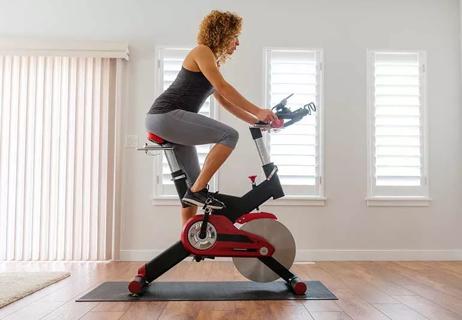A type of high-intensity interval training, fitness boxing can challenge your body and mind

When you’re feeling tense and frustrated, a good workout can help. Fitness boxing, which is a form of exercise that has roots in traditional boxing, offers a safe outlet for your emotions — not to mention an awesome workout.
Advertisement
Cleveland Clinic is a non-profit academic medical center. Advertising on our site helps support our mission. We do not endorse non-Cleveland Clinic products or services. Policy
Think boxing might be right for you? Physical therapist James Edwards, DPT, discusses why fitness boxing is good for you and how to steer clear of injuries.
Traditional boxing prepares fighters to spar in a ring, while fitness boxing is a form of high-intensity interval training (HIIT) that challenges your body and mind.
“Boxing combines punching drills and conditioning exercises that can improve your heart health, strength, endurance, balance and coordination,” Dr. Edwards says. “It can also reduce stress, anxiety and depression and improve your confidence and overall well-being.”
A typical fitness boxing class includes a series of drills to keep you moving. Your class may include a mix of:
Both traditional and fitness boxing are great workouts, but fitness boxing is certainly safer. You’re not taking any punches to the face or body — just getting in a great sweat sesh.
Both traditional boxing and fitness boxing bring a number of health benefits, both physical and emotional — and the more you box, the bigger the benefits!
Advertisement
Dr. Edwards breaks them down for you.
Regular physical activity, including boxing, can lower your blood pressure, your cholesterol and your risk of heart disease.
To achieve these benefits, the U.S. Department of Health and Human Services’ Physical Activity Guidelines recommend one of these activity levels for adults:
When you’re boxing, you’re likely to exert moderate- to vigorous-intensity effort. Moderate intensity means you’re at about 50% of your maximum level of exertion. With vigorous exercise, your intensity is 70% to 80%. Want to track your activity levels? Consider purchasing a heart rate monitor.
“A monitor can help you maintain your heart rate during exercise and make sure you’re not overexerting yourself,” Dr. Edwards says.
Traditional boxing prepares fighters for four to 12 rounds in the ring. Each round is three minutes with a one-minute rest.
“The drills in fitness boxing provide a similar level of conditioning that translates to better stamina,” Dr. Edwards explains.
“Throwing a punch works your entire body, from your arms and shoulders all the way to your core and legs,” Dr. Edwards says.
The conditioning exercises in fitness boxing classes also use a whole-body approach. You’ll tone muscles you never knew you had!
The calories you burn during boxing can help you maintain or achieve a healthy weight.
One study compared boxing training versus moderate-intensity walking in people with a body mass index (BMI) of greater than 25 (which is considered having overweight/obesity). The researchers noted reductions in BMI, waist circumference and body fat percentage in the boxing group, while the walking group showed no changes.
Exercise is key to good balance, especially as you age.
“Boxing can give you better agility and hand-eye coordination,” Dr. Edwards notes. “It also helps build a strong core, which is essential for maintaining your equilibrium.”
Boxing training may be an effective therapy to improve balance and reduce falls in people with brain disorders. One early study found that twice-weekly virtual boxing training reduced falls in people with Parkinson’s disease, while another study showed that boxing training improved balance in people who had a stroke.
Boxing drills can be a form of moving meditation.
“Punching requires intense focus,” Dr. Edwards states, “and the constant movement and HIIT exercises during class leave little time for deep thought.”
Advertisement
Individually, meditation and HIIT offer a range of mental health benefits. Together, they deliver a double punch of rewards. According to a review of 16 studies, the mental health benefits of boxing include:
The saying “An ounce of prevention is worth a pound of cure” holds true for all sports, including boxing: Taking preventive steps can help you avoid injuries.
Dr. Edwards shares tips for staying injury-free:
Advertisement
And do your due diligence ahead of time.
“If you aren’t used to high-intensity exercise, be sure to check with your healthcare provider to make sure it’s safe for you,” Dr Edwards advises.
If you’ve never thrown a punch, a boxing class may seem intimidating. But many gyms welcome beginners and go out of their way to help new students learn the ropes.
“It can be helpful to have a basic level of fitness, but you don’t need any previous boxing experience to get started,” Dr. Edwards says.
To get off on the right foot:
Anyone who’s taken a boxing class knows it’s great exercise. But that’s only one reason to choose boxing. Learning to punch — even if it’s only for fitness — can be empowering. You may even find that it gives you the strength and confidence to better navigate life’s challenges.
Advertisement
Learn more about our editorial process.
Advertisement

Running doesn’t cause knee arthritis, but you can take steps to minimize cartilage damage

Fit, duration and positioning are more important than you might think

What you should know before hitting a race before the big Thanksgiving meal

How to make the most out of cycling

As a training tool, ditching your shoes could help you build better running form to avoid injury

Fast facts for anyone starting a running routine

Why aren’t mental health issues taken as seriously as physical issues?

Here’s what runners can expect as they return to starting lines

Type 2 diabetes isn’t inevitable with these dietary changes

Applying a hot or cold compress can help with pain